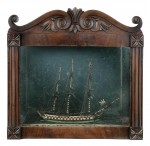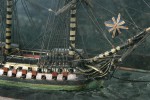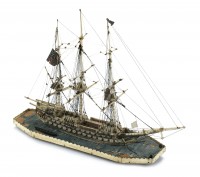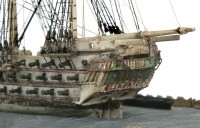One of my favorite posts last year was about a model of a guillotine made out of animals bones by a Napoleonic prisoner of war in England. Britain had a surfeit of prisoners from France and other countries who fought on Napoleon’s side during the late 18th, early 19th century. An estimated 100,000 Napoleonic prisoners were in British hands between 1793 and 1815 because of French Revolutionary and Napoleonic policies against the ransom or exchange of prisoners. Prison hulks had nothing like that capacity, so a number of prisoner of war camps were built in England, the first permanent POW camps of their kind.
These camps weren’t the extreme hellholes that prison hulks were, but they were still overcrowded, wet and subject to epidemics like Typhus. British authorities allowed the prisoners to make crafts and sell them to supplement their miserable existence. Since many of the prisoners were conscripts rather than professional soldiers, they had work skills from their civilian lives and were able to create rather exceptional pieces. The working model of a guillotine carved from discarded bones is one of them. Beautifully appointed model ships were also popular.
Two of those ships are coming up for sale at Bonham’s Fine Maritime Paintings and Decorative Arts auction on June 5th in New York. One is a model of a 76-gun French ship-of-the-line made out of bone. The other is a boxwood model of a British 76-gun ship-of-the-line. Both were carved around 1800 and are amazingly elaborate. The boxwood model is valued at least $2,000 higher than the bone one because of how crazy fancy it is:
in a diorama format with the hull built up from the waterline, a painted green bottom, the topsides painted in alternating bands of black, pink and white, and black topsides fitted with a figure head of a Roman warrior, at the stern the quarter galleries and transom are modeled with windows, cut and pierced and decorated with a geometric pattern. The decks are of veneer with the planking lines drawn in and detailed with: anchor, cannons on carriages, pin and fife rails, capstan, railings, ladders, belfry, hatches, deck eyes. At anchor, one anchor rode is run out into the sea as if the ship were anchored. Rigged with three masts, bowsprit, standing and running rigging, turning blocks, cross spars, tops and trees, and dead-eyes and other rigging details. Displayed on a carved and painted sea, framed by an ornately decorated and drawn acanthus base, within a mahogany and glass case with carved front columns and a foliate frieze over the top.



The bone ship is slightly less fancy, but no less amazing:
possibly Le Maroc [name on transom barely legible], the hull built up from the solid and planked in bone, between the gun decks are raised bone strakes which were painted black, brass guns fitted to the topsides and decks, chain plates and dead-eyes, polychromed figurehead of a warrior, carved and pierced stern and quarter galleries with verdigris copper details, head rails, pin and fife rails, scored planking for the decks, open well deck, guns on carriages, taff rail, and other details. Rigged with masts, yards, standing and running rigging, spars, stun’sail booms, and other details [rigging in need of attention]. Set into a bone and wood base with a painted sea [distressed] giving the impression of a waterline model.


I’m partial to the bone one both because I’m just a fan of bone art in general and because you can really see that it was made out of bits of carved bone. On the other hand, it does not have a Roman legionary figurehead so the boxwood model clearly wins on that score.